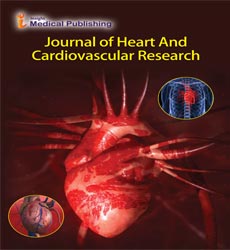ISSN : ISSN: 2576-1455
Journal of Heart and Cardiovascular Research
Nanotech Advancements: A Beacon for Coronary Patients
Bing Xia*
Department Nanomaterials and Nano-safety, The Chinese University of Hong Kong, Hong Kong SAR, China
- *Corresponding Author:
- Bing Xia
Department Nanomaterials and Nano-safety,
The Chinese University of Hong Kong, Hong Kong SAR,
China,
E-mail: Bing@gmail.com
Received date: November 15, 2023, Manuscript No. IPJHCR-24-18476; Editor assigned date: November 20, 2023, PreQC No. IPJHCR-24-18476 (PQ); Reviewed date: December 04, 2023, QC No. IPJHCR-24-18476; Revised date: December 11, 2023, Manuscript No. IPJHCR-24-18476 (R); Published date: December 18, 2023, DOI: 10.36648/2576-1455.7.03.51
Citation: Xia B (2023) Nanotech Advancements: A Beacon for Coronary Patients. J Heart Cardiovasc Res Vol.7 No.3:51.
Introduction
Congenital Heart Disease (CHD) is a constant infection that includes a mix of various types of hazard factors, like smoking, hyperlipidemia, hypertension, diabetes, and age. It can persevere for a really long time or even many years. In the beginning phases of pathogenesis, openness to atherogenic risk variables can prompt endothelial harm. This harm further makes the enactment of mononuclear macrophages phagocytose cholesterol and animate aggravation. Monocyte macrophages overwhelm oxidized Low-Density Lipoprotein (bull LDL) into froth cells, which store in the vascular wall, prompting early changes in atherosclerosis. With additional improvement of the illness, froth cells become necrotic, and intracellular lipids are delivered into the lipid pool, which is the premise of atherosclerotic plaque. Furthermore, under the feeling of atherosclerosis, the Smooth Muscle Cells (SMCs) of the vascular media multiply and move to the intima to shape fiber covers. The sinewy cap framed by SMCs and the lipid pool got from froth cells comprise the principal part of the atherosclerotic plaque. Under ordinary conditions, the plaque would be steady on the off chance that it had a thick stringy cap and high collagen content. Sadly, notwithstanding, relentless irritation and the presence of metalloproteinases could cause collagen debasement and plaque corruption center expansion, transforming stable plaque into shaky ones, and crack happens. This could additionally bring about apoplexy and complete impediment of the coronary lumen, prompting the advancement of intense myocardial localized necrosis. Subsequently, atherosclerosis fills in as the essential driver of CHD improvement, and myocardial dead tissue remains as its most outstanding sign.
Symptomatic Strategies
At present, the essential symptomatic strategies for CHD depend on coronary angiography and the discovery of myocardial injury markers like Creatine Kinase MB (CK-MB), Cardiac troponin I (cTnI), and Cardiac Troponin T (cTnT). In any case, coronary angiography is costly, tedious, and low goal, which makes it trying to meet the early conclusion necessities of CHD. Recognition of myocardial injury markers has been generally utilized in centers, yet it likewise has limits like low awareness and the event of misleading adverse outcomes. As far as CHD treatment, the essential treatment strategy incorporates medication to control blood lipids, blood glucose, circulatory strain, irritation, and so on. In any case, long haul utilization of these medications is joined by secondary effects. For instance, statin lipid-bringing down drugs are broadly utilized in patients with hyperlipidemia and CHD yet could undoubtedly cause rhabdomyolysis and liver harm. Furthermore, patients with CHD normally require consuming various medications in blend for quite a while, which might decrease patients' consistence and prompt unusual results. By and large, previously mentioned medications can altogether diminish the rate of intense CHD occasions; however they can't fix the infection totally In any case, this treatment is dangerous. The age of Receptive Oxygen Species (ROS) after PCI treatment incites Reperfusion Injury (RI), which increments cardiomyocyte demise. Since cardiomyocytes in nature can't multiply, such PCI-actuated RI could cause weakened cardiovascular capability and influence patients' visualization after MI. At present, conventional judgments medicines of CHD actually face huge difficulties. Nanotechnology offers new methodologies for clinical applications in view of the novel properties of nanoparticles.
Diagnosing and Treating
These properties give nanoparticles many benefits over ordinary medications in diagnosing and treating CHD. Nanoparticles have attractive, optical, electrical, and warm properties that empower imaging and biosensing for the early location of CHD. For example, they can upgrade different imaging modalities by giving biocompatible, designated and multimodal nano-contrast specialists that work on the goal of mind boggling tissues contrasted with ordinary difference specialists. For instance, numerous nanoparticles can increase Computed Tomography (CT) and Positron Emission Tomography (PET) checks. Also, the electrical and optical properties permit them to be utilized as viable electrical/optical biosensors for early biomarker location of CHD. Nanotechnology can empower quicker, more delicate and more exact location of markers of myocardial injury, for example, cTnI and cTnT by utilizing electrochemical and optical biosensors. These nano-sensors exploit nanomaterials, for example, metal nanoparticles, carbon nanotubes and directing polymers as sign intensifiers or transporters that improve the cooperation and sign transduction with myocardial injury markers. Some nano-sensors can recognize examples at focuses under 10 picograms, a standard that can't be accomplished by Enzyme-Linked Immunosorbent Assay (ELISA).
Open Access Journals
- Aquaculture & Veterinary Science
- Chemistry & Chemical Sciences
- Clinical Sciences
- Engineering
- General Science
- Genetics & Molecular Biology
- Health Care & Nursing
- Immunology & Microbiology
- Materials Science
- Mathematics & Physics
- Medical Sciences
- Neurology & Psychiatry
- Oncology & Cancer Science
- Pharmaceutical Sciences
